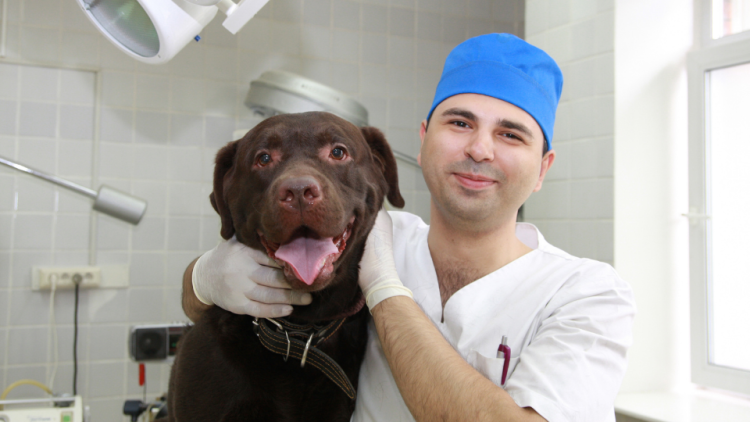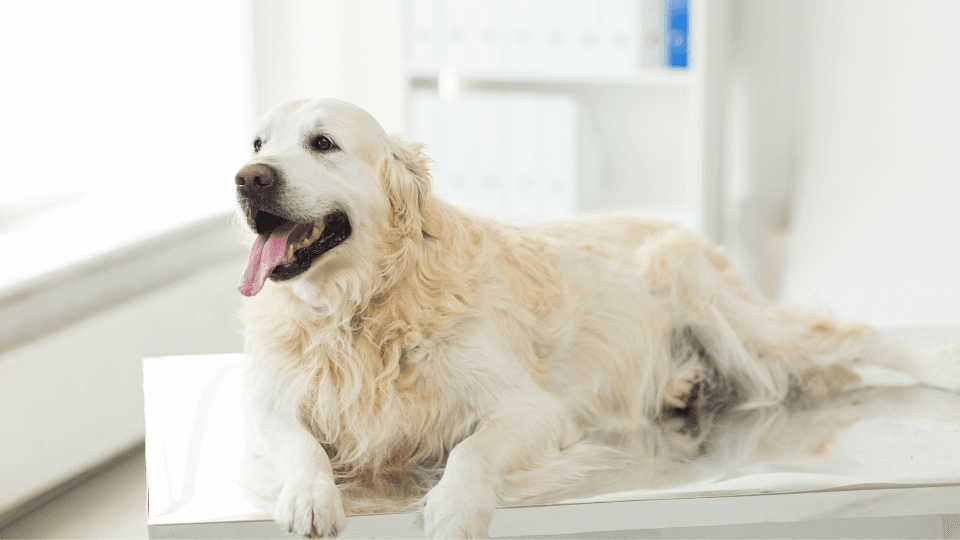If you notice a lump has appeared overnight on your dog’s neck, chest, leg, or back, don’t panic. Many pet parents will fear their dog has cancer, but before you jump to the worst-case scenario, schedule an appointment with your vet to evaluate the lump. It may be a lipoma.
A lipoma is a common type of tumor that affects approximately 16% of dogs1. Though the word “tumor” may sound frightening, it’s important to know that these abnormal growths are benign fat build-ups and typically harmless.
In this article, we’ll cover everything you need to know about canine lipomas, removal costs, treatment methods, and more.
Table of Contents
- What is a fatty tumor (lipoma)?
- Can lipomas be cancerous?
- What does a lipoma look like?
- What causes fatty tumors in dogs?
- Diagnosing lipomas in dogs
- How to treat canine lipomas
- Canine lipoma removal cost
- Recovery and prognosis
- Can lipomas be prevented?
- Key Takeaways
Pro Tip: Not sure whether you should take your dog to the vet to get a lump checked out? With pet insurance, you can worry less about the cost of vet visits with peace of mind knowing that you’ll be reimbursed for out-of-pocket expenses spent on covered medical conditions.
What is a fatty tumor (lipoma)?
Lipomas, also known as adipose tissue tumors, arise from fat deposits that grow at a different rate from the surrounding fat, leading to the formation of a lump below the skin of dogs (humans get them, too). The pronounced lump often feels soft and moveable, and is usually not attached to the muscle below. The tumor is usually well-encapsulated, meaning it has a defined border, which makes it easy to remove surgically, if needed.
Lipomas are usually harmless, but in certain locations — such as under the armpit or in the groin — they can limit mobility. The majority are benign, meaning they’re not cancerous and will not spread (or metastasize) throughout the body in the way malignant tumors can. However, some dogs will form multiple lipomas in various locations on their body throughout their life.
There is also a more aggressive form of lipoma, called an infiltrative lipoma. This type of growth is still benign but has less defined borders and is more difficult to remove surgically.
Note: “Lipoma” sounds very similar to, but is not the same as, lymphoma in dogs, which refers to a very aggressive form of cancer in the lymph nodes.
Can lipomas be cancerous?
In very rare cases, a fatty tumor is actually a malignant growth called a liposarcoma. This type of cancerous mass develops from fat cells, grows quickly, is very locally invasive, but will rarely metastasize (or spread) to other areas of the body.
Liposarcomas require aggressive surgery to remove. Unfortunately, depending on the tumor’s size, location, and invasiveness, it may not be possible to remove it entirely. For these cases, follow-up therapy, such as radiation, is recommended.
What does a lipoma look like?
Lipomas usually start as a small, round bump under the skin. The size of the lump will depend on how much fat the tumor contains, but canine lipomas can appear quite large. Usually, they’re soft and somewhat movable, although firmer masses or ones that are more firmly attached to the underlying tissues are also common.
Fatty tumors often appear on dogs’ neck, leg, chest, and back. Many dogs develop multiple lipomas on the body at once. Obese dogs tend to develop larger lipomas than others, and the fat deposits might shrink with weight loss, but typically do not disappear completely.

What causes fatty tumors in dogs?
The exact cause of lipoma in dogs is not yet fully understood. They are more likely to occur in mid- to senior-aged dogs over eight years old. Overweight adults are especially at risk.
Some dog breeds are more prone to lipomas than others, including:
- Dachshunds
- Beagles
- Doberman Pinschers
- American Cocker Spaniels
- Miniature Schnauzers
- Weimaraners
- Labrador Retrievers
Diagnosing lipomas in dogs
Lipomas cannot be diagnosed by palpating, or feeling, the lump. If you notice a lump on or under your dog’s skin, you should schedule an examination with your veterinarian. They will perform a full physical examination and may take measurements of the lump.
Your veterinarian will likely recommend a fine-needle aspirate (FNA) to determine the type of cells that form the lump. An FNA is a minimally invasive, quick test that can be performed in the clinic. Your veterinarian will insert a small needle into the lump and remove some cells with a syringe.
These cells will be placed on a slide and examined microscopically by your veterinarian or a veterinary pathologist. Aspirates typically cost between $50 and $200 depending on whether the cells are sent to a pathologist for review.
It’s important to note that this test only samples a small number of cells in what is sometimes a very large lump beneath dogs’ skin, so it may not be 100% accurate. Pet parents should continually monitor all lumps for changes in texture, size, and appearance, and call your veterinarian if you notice changes like these.
How to treat canine lipomas
The majority of fatty tumors in dogs are harmless and do not require treatment. In most cases, monitoring the lump for changes over time is the best approach. There is no reliable medical therapy for lipomas. To get rid of a dog’s lipoma completely, it must be surgically removed. This requires general anesthesia, which does carry some risks and is generally not recommended for cosmetic purposes only.
Veterinarians usually recommend surgical removal of a lipoma if the lump is big enough to:
- Impede the dog’s movement
- Interfere with normal body functions
- Cause discomfort
Rarely, adipose tumors might become infected or injured, in which case, surgical removal is usually the best option. If the lipoma becomes locally invasive, surgical removal may need to be followed by radiation therapy to help limit regrowth.

Canine lipoma removal cost
Surgical removal is usually several hundred dollars per lump, which will include pre-anesthetic testing (such as bloodwork), anesthetic medications, an intravenous catheter, surgical removal, surgical supplies, and post-operative medications.
The cost of surgical lipoma removal will vary based on the size of the mass and its location. The size of your dog and the duration of surgery may increase the cost of removal. If the lipoma is very big, highly invasive, or in a difficult-to-access spot, then surgery expenses can reach or exceed $1,000 — especially if a board-certified surgeon performs the surgery.
Your veterinarian will likely recommend that any tissue removed at surgery is sent to a veterinary pathologist for a biopsy. This test will confirm that the lump is indeed a lipoma and there are no other abnormal cells within the mass. For infiltrative lipomas or liposarcomas, a biopsy will be necessary to determine if the surgeon was able to get clear margins, meaning there are no tumor cells present microscopically at the edge of the removed tissue.
Pro Tip: Many pet insurance plans cover the cost of diagnostic tests and physical examinations essential to ensuring your pup’s health, with reimbursement rates as high as 100%.
Recovery and prognosis
In most cases, a lumpectomy to remove a lipoma is an outpatient procedure, meaning your dog will come home the same day. In rare cases of more invasive lipomas, your vet may recommend overnight observation.
Most lipomas are fairly easy to remove because of their well-defined borders, though the incisions can be quite large depending on the tumor size. In some cases, your veterinarian may place a drain under the skin to prevent fluid from building up at the tumor removal site. This drain will need to be monitored and removed several days after surgery.
Once your pet is home, you’ll need to administer anti-inflammatory medication and dog pain relievers per the directions provided by your vet. Do not use over-the-counter medications. Your vet will also likely send home an Elizabethan collar (E-collar or “cone of shame”) to ensure your dog doesn’t bite, lick, rub, or scratch the incision. Doing this can delay healing and lead to infections. You will also need to monitor the incision site for swelling, bleeding, redness, or irritation.
Most lipomas are easily removed with surgery and rarely recur, though they can form in other locations. Unfortunately, regrowth rates following surgery for malignant growths are higher, with a 36% recurrence rate for infiltrative lipomas. In some cases, follow-up therapy, such as radiation, is recommended.
Can lipomas be prevented?
Researchers do not yet definitively know what causes lipomas in dogs, so it can be challenging to prevent them from occurring. Overweight and obese dogs are more likely to develop adipose tumors, so maintaining a proper weight through exercise and diet may help.
Key Takeaways
- Lipomas are fatty tumors located under the skin and can occur on any part of a dog’s body. They’re typically harmless unless they interfere with the animal’s mobility due to their location.
- Although lipomas can appear on any dog, older and overweight pets are at a greater risk.
- Lipomas are diagnosed with a fine needle aspirate, and most have no impact on the dog’s overall health, so removal is often unnecessary.
- Although the majority of lipomas are benign, there are more aggressive and malignant forms so you should have all lumps checked by your veterinarian.
- Pet insurance can help to cover the costs of diagnosing and removing a lipoma.
References
- Embrace, “Lipoma” Accessed Sept. 27, 2021.
